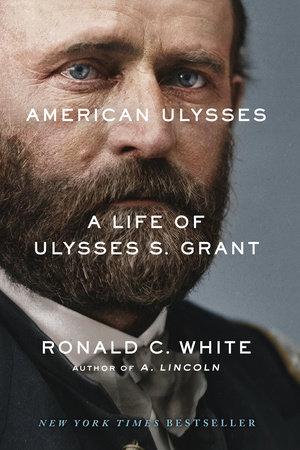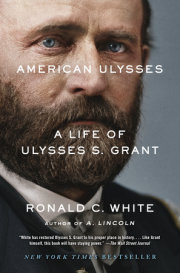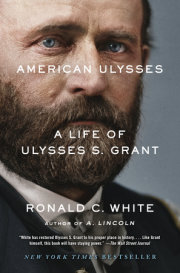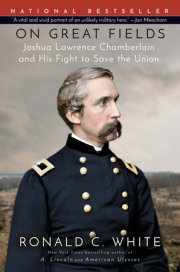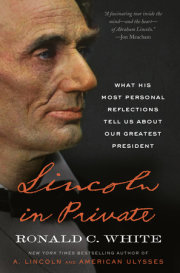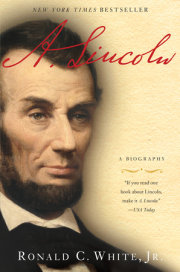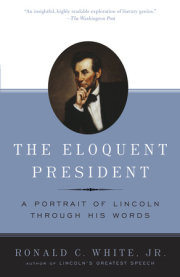CHAPTER 1
“My Family Is American”
My family is American, and has been for generations, in all its branches, direct and collateral.
—Ulysses S. Grant, Personal Memoirs
Although he was celebrated in his lifetime as a prime example of the mythic American self-made man, Ulysses S. Grant understood the formation of his life to be a family affair. His appreciation looked back through the prism of seven generations and two hundred years of Grants.
Matthew and Priscilla Grant sailed from Plymouth, England, on March 20, 1630. Married for five years, the Grants were “West-country people” from Dorsetshire in southwest England. Their home that spring would be the Mary and John, a four-hundred-ton wooden ship very much like the Mayflower, which had carried the first Pilgrims to a new England only ten years earlier. The Grants sailed with 138 other passengers who traveled together as members of a congregation, complete with two ministers and lay officers.
The Mary and John would be one of seventeen ships sailing from England to the New World between February and August 1630. In the next eleven years, nearly three hundred ships would carry twenty thousand passengers in a huge exodus called “the Great Migration.” Disdainfully dubbed “Puritans” by opponents, these immigrants hoped to purify the Church of England according to the best ideas of the Reformed or Calvinist churches of Europe, which traced their origins to John Calvin of Geneva in the previous century. The Grants joined Puritans who hoped to restart their lives in a new land where they could escape persecution by both King Charles I and Archbishop William Laud and put their religious and political ideas into practice.
After seventy perilous days sailing across the North Atlantic, the Mary and John made its way into the narrow entrance of the Boston harbor. Following their arrival in the Massachusetts Bay Colony, the first American Grants helped settle the new town of Dorchester (now part of Boston). Priscilla Grant died after bearing four children in as many years.
In 1835, five years after his arrival, Matthew Grant linked his dreams with the Reverend John Warham and fifty-eight members of the Dorchester parish in journeying 105 miles to begin another new town, Windsor, at the confluence of the Connecticut and Farmington rivers in the Connecticut Valley. The first English settlers traveled west, displacing Native Americans, who were already being killed off in large numbers by disease. Matthew would come to occupy a central place in the new community, serving as town clerk, county surveyor, and deacon of First Church.
Henry Reed Stiles, writing The History of Ancient Windsor, Connecticut in the nineteenth century, stated, “Few men indeed filled so large a place in the early history of Windsor, or filled it so well, as honest Matthew Grant! His name figures in almost every place of trust.” Grant represented, for Stiles, “a type of the best settlers of New England, and left to his descendants an untarnished name and the example of an unswerving fidelity to the public trusts committed to him.” In reflecting on the Puritan priority of the community over the individual, Matthew Grant declared: “I have been careful to do nothing upon one man’s desire.”
The next five generations of Grants were Connecticut Yankees, spreading across Windsor, East Windsor, and Tolland, Connecticut. Young Ulysses knew the story of his great-grandfather Noah, Matthew Grant’s great-great-grandson. Born in 1718, Noah grew to manhood as the English and French struggled for domination on the North American continent. Ulysses enjoyed recounting how Noah and his brother Solomon held commissions in the English army in the war against both French and Indians. Noah and Solomon were killed in separate battles in New York in 1756.
Noah’s son, also named Noah and Ulysses’s grandfather, was only nine years old when his father and uncle were killed fighting under the flag of the king of England. Born in 1748, this Noah enlisted in the Continental army after the Battles of Lexington and Concord. Ulysses would recount proudly how his grandfather was present at the Battle of Bunker Hill. He believed his grandfather served through the entire Revolutionary War, and this heritage would become central to Grant’s self-identity.
As a new nation emerged after the war, Noah Grant struggled to make a living as a farmer and cobbler in the Connecticut Valley. When his wife, Anna Buell Richardson Grant, died, he decided to join some of his neighbors in settling lands opening in western Pennsylvania. He traveled 475 miles before building a cabin along the wooded banks of the Monongahela River near Greensburg in southwestern Pennsylvania. There, Noah married Rachel Kelley, daughter of an Irish pioneer, and began acquiring more babies and lands.
Jesse Root Grant, who would become Ulysses’s father, was born on January 23, 1794.
When Jesse turned five years old, the Grant family moved yet again. At age fifty-one, Noah loaded his family on a boat, the popular means of transportation west. At the village at Fort Pitt (today’s Pittsburgh), they turned southwest and floated onto a broad watercourse known as the Ohio (adopted from the Seneca O-hi-yo, meaning “Great River”). They stopped at the first village beyond Pennsylvania, a picturesque hamlet that fronted a serpentine bend of the majestic river. This was Fawcettstown (now East Liverpool), named after its founder, Thomas Fawcett, who had established the community just the year before.
The newly settling Ohio Country was part of lands ceded by the British to the United States at the end of the Revolutionary War. Four seaboard states, Massachusetts, Connecticut, New York, and Virginia, gave their western lands to the new federal government to form the Northwest Territory. On July 13, 1787, Congress ratified the Northwest Ordinance, establishing a system of government for this territory reaching all the way to the Mississippi River.
Even though the new federal government, in order to attract the participation of all thirteen colonies, had not taken a stand on slavery in the new Constitution, the founding Congress looked far to the future and decreed, “There shall be neither slavery nor involuntary servitude in the said territory.”
By 1800, the young nation comprised five million people divided into sixteen states plus the Northwest and Mississippi territories. On February 19, 1803, President Thomas Jefferson signed the law authorizing Ohio as the first state organized in the Northwest Territory and the seventeenth state in the United States.
When Jesse turned ten, Noah moved the family forty-five miles through virgin forests to Deerfield Township in Warren County. One year later Jesse’s mother, Rachel Grant, the family’s stable center, died. At age fifty-seven, Noah—work-shy and too fond of alcohol—decided to break up his family. The two oldest children, Susan and Jesse, were expected to find their way with relatives or neighbors. For the next three years, Jesse would work for several farmers in the area, earning his board and room but not much more.
In 1808, Jesse went to work for the Tod family on their farm near Youngstown, Ohio. Over the next two years, a new world opened up for the fourteen-year-old. George Tod, a respected politician and jurist, was a father figure to young Jesse, introducing him to political discussion. Among Jesse’s playmates was little David Tod, only three years old, who would become governor of Ohio during the Civil War.
In the evenings, with George often away serving as a judge on the Ohio Supreme Court, his wife, Sally, furthered Jesse’s reading through books she provided. Encouraged by his eagerness to learn, the Tods sent Jesse to a subscription school for two winter terms—the only formal education he would receive in his life. Years later, Ulysses would recall his father saying that Sally Tod was “the most admirable woman he had ever known.”
The Tods suggested to Jesse that the occupation of tanning would be more financially rewarding than farming. At this time, technological innovations were facilitating the purchase of leather goods by all classes of society, because leather products became cheaper and the process became more accessible. In 1805, Sir Humphry Davy, a British chemist and inventor, found that trees other than oak could be utilized in the tanning process. Ash, chestnut, hemlock, and mimosa trees, all plentiful in the United States, quickly expanded tanning resources. American Samuel Parker further advanced the tanning industry in 1809 by inventing a machine to split hides. With the aid of Parker’s invention, one man could split up to one hundred hides in a single day. The need for leather goods grew apace with rapid population growth in the West.
Jesse had watched his own father, Noah, begin with extensive property and lose nearly all of it. During his teenage years, Jesse determined to work diligently in order to acquire the culture and possessions he had discovered in the Tod home.
Jesse set out to be a tanner. In 1810, he traveled to Maysville, Kentucky, to ask his older half-brother, Peter, if he could learn the tanning business as his apprentice. Under Peter’s guidance, Jesse saw that he could advance by tanning leather for everything from shoes and boots to harnesses and saddles. In addition, Peter taught Jesse how to manage his financial affairs and run a business, skills equally important to the craft of tanning and something their father, Noah, had never learned.
In 1815, having completed his commitment to Peter, Jesse returned to Ohio. He wanted to go back to the land and people he knew, but he would also say later of his move back across the Ohio River, “I would not own slaves and I would not live where there were slaves.”
In Ohio young Grant, now twenty-one, went to work for Owen Brown, a burly man who operated a successful tannery in Hudson, twenty-five miles southeast of Cleveland. In his year with the outspoken Brown family, Jesse heard constant conversation about the evils of slavery. While participating in a cattle drive to an army fort, Owen’s son John had seen a young black boy beaten with an iron fire shovel. John Brown returned to his family filled with an anger that would grow until it exploded decades later in Kansas and finally at Harpers Ferry in 1859. In Hudson, John Brown would assert his indictment of slavery to anybody who would listen. Jesse listened.
In 1817, Jesse was invited to become the operating partner of a tannery in Ravenna. Within two years, his hard-work ethic turned the joint venture into a success. He saved his earnings and accumulated the considerable sum of $1,500—nearly $27,000 in today’s money.
In January 1820, Grant moved to Point Pleasant, a village on the Ohio River twenty-five miles southeast of Cincinnati, to work as foreman in a new tannery. Thomas Page hired Jesse in part because he wanted him to teach the craft of tanning to his own son. Jesse’s new goal became acquiring enough money to start his own tannery.
At age twenty-five, Jesse had another goal: finding a wife. Page pointed his young employee thirteen miles north, near the crossroads town of Bantam, to the home of John and Sarah Simpson. Descended from Scottish Presbyterians, the Simpsons, while living in Montgomery County, Pennsylvania, had caught “Ohio fever.” They headed west in the summer of 1817, gliding the final miles on a flatboat. Upon arriving in Bantam, the Simpsons purchased six hundred acres of fertile land for $6 an acre from Page and built a brick house.
Jesse appreciated the stability he encountered in the Simpson family, enjoyed the books he read in their house, and felt comfortable in their company. Of the three Simpson daughters, he felt drawn to the eldest, Hannah. Jesse described Hannah as “a plain unpretending country girl, handsome but not vain.” A neighbor described her to be of “Christian character,” whom everyone found “graceful in manner.” Five years younger than Jesse, she attracted him with her quiet kindness and patience. Hannah seemed quite a contrast to the voluble Jesse.
Sometimes, opposites do attract. Jesse and Hannah married on June 24, 1821, in her family home.
The young couple moved into an unadorned one-story frame house Jesse had rented next to the tannery in Point Pleasant. Built in 1817 of Allegheny pine, the small house was 16 by 19½ feet, with two rooms and a large fireplace on the north side. A majestic expanse of Indian Creek flowing south into the Ohio River dominated the view from the front of the cabin; standing in their doorway, Jesse and Hannah could watch the Daniel Boone and the Simon Kenton, stern-wheel steamers named for two heroes of the Kentucky frontier, pass by on the way to St. Louis or Pittsburgh. In the back, a hill sloped up to the surrounding forests of ash, oak, and walnut.
Ten months and three days after their marriage, on April 27, 1822, Hannah gave birth to their first child, a boy weighing a hefty ten and three-quarter pounds. Jesse decided this first member of the eighth generation of American Grants would remain unnamed until a proper family convocation could be held.
A month later, the Grant and Simpson families gathered at the Simpson family home for a naming ceremony. The lusty infant, a charmer with blue eyes and reddish-brown hair, held center stage as a remarkable dialogue began. Hannah, a fierce Democrat, suggested the name “Albert,” in honor of Albert Gallatin from her home state of Pennsylvania, who had served both in Congress and as secretary of the Treasury under President Thomas Jefferson. Hannah’s younger sister, Anne, suggested “Theodore.” John Simpson favored “Hiram,” which he thought a handsome name. Sarah Simpson, caught up in reading French novelist François Fénelon’s The Adventures of Telemachus—the romantic story about the son of mythical Greek general Ulysses, who defeated the Trojans—spoke up strongly for “Ulysses.” Jesse seconded her nomination, in part because he had loaned his mother-in-law this book from his personal library and wanted to please her. In the end, someone suggested drawing lots to decide. After depositing the names in a hat, the youngest Simpson, Anne, drew out the name “Ulysses.”
Wanting to honor his father-in-law, Jesse announced that the baby’s name would be “Hiram Ulysses.” But Jesse never called him “Hiram.” Bubbling with pride, he insisted from the beginning on calling his firstborn son “my Ulysses.”
“Ulysses” was certainly not the name of any previous noteworthy American. It was not the biblical name—Matthew, Samuel, Noah—of the previous Grant generations. “Ulysses” would be the most unusual name of an American Grant.
The baby boy with the Greek name had much to live up to. Fénelon tells the story of the moral and political education of Telemachus, the young son of the Greek hero Ulysses. In the course of the novel, Telemachus travels to every part of the Mediterranean world. Along the way he learns, by trial and error, the virtues of courage, humility, patience, and simplicity. These were all the traits he would need if he was to succeed his heroic father, Ulysses, as a ruler.
Jesse and Hannah Grant, on naming day, were putting their family hopes on little Ulysses.
Copyright © 2016 by Ronald C. White. All rights reserved. No part of this excerpt may be reproduced or reprinted without permission in writing from the publisher.

